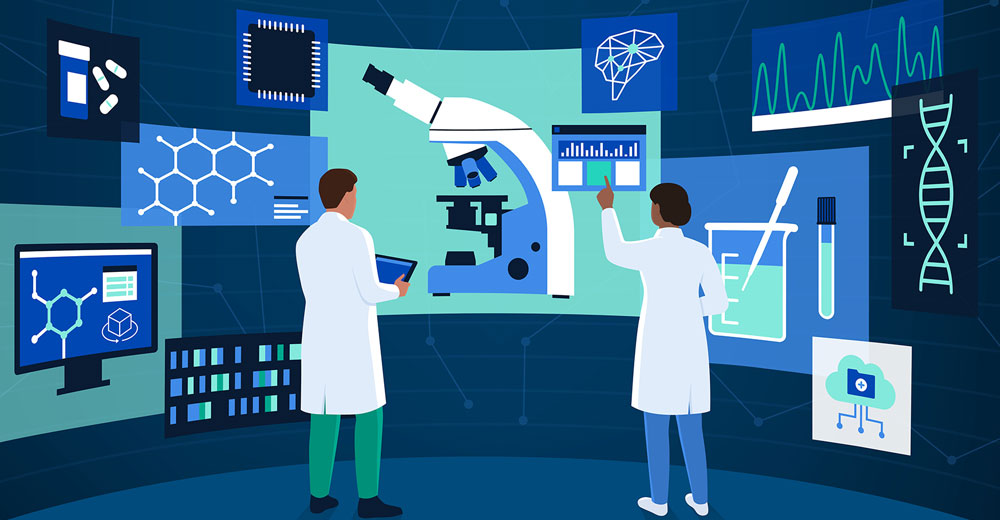Biopharmaceutical companies are looking for go-to-market approaches that go beyond customer expectations. Starting with a revolutionized technology platform allows these organizations to create value beyond a prescription and basic instructions.
For example, in the case of diabetes, the data and digital platform would be able to share information that would benefit the patient, such as if they ate at a different time or slept more. These suggestions through commercial models are possible for chronic and complex conditions like multiple myeloma.
Biopharma companies are radically rethinking their commercial operating models to gain stronger business foundations. These new approaches, in turn, will help them to serve patients better and withstand competition.
Although some companies in this science field were dabbling in this remodeling structure before the pandemic, the Covid crisis intensified trends calling for more rapid and fundamental marketing transformations.
One central element in this need for pharma firms to transform is creating digital solutions that empower patients, enable clinicians, and integrate with a distributed care environment, according to Brian Williams, managing principal for software development firm Life Sciences Business Consulting at EPAM Systems.
The life sciences industry includes biopharmaceutical manufacturers and producers of medical devices such as imaging, in vitro diagnostics (IVD), implants, and orthopedics. The field also includes other entities involved in researching and manufacturing drugs and devices used in human and animal health.
“Both government and commercial payers are migrating from traditional fee-for-service reimbursement to value-based models,” Williams told TechNewsWorld.
Medicare Pushing Toward New Models
The Covid-19 pandemic slowed this migration, Williams continued. But the intent to move toward value-based models is demonstrated by the Centers for Medicare and Medicaid Services (CMS) plan to transition all covered persons to an accountable care relationship by 2030.
“For life sciences companies, value-based reimbursement models will require demonstrable proof that their interventions delivered a beneficial health outcome,” he explained.
These outcomes could range from an improvement in mobility, a base biometric data point such as a lower A1C level for a diabetic patient, or in some instances, a cure.
Additionally, Williams observed that the pandemic allowed consumers to become more confident and comfortable engaging in health care services outside traditional clinical settings, such as in their neighborhood retail clinic or virtually at home.
“This shift in care access points now requires biopharmaceutical companies to adopt more consumer-facing, digital-first solutions that facilitate patient engagement, compliance, and adherence,” he said.
New Marketing Trends for Pharmacology Firms
Covid-19 forced pharmacology experts to broaden their marketing activities. The aftermath of the pandemic continues to see an expanded marketing toolbox for health drug and medical device makers. Post-Covid research is just one trend putting go-to-market activities on the front burner of laboratories.
For instance, mRNA-based Covid-19 treatments earned billions of dollars for their developers during Q1-Q3 2021. Those developments continue as drug makers find new outlets for more modern-day medical discoveries. Artificial intelligence is attracting collaboration funding for discoveries found more quickly than previously possible for human-only experimenters.
Add to this money source for enhanced research the windfalls involved in cell and gene therapies. Reports show developers raked in $6.4 billion for 376 gene therapy trials in the first half of 2021 alone. Investors poured $24 billion in venture capital funding for biotechnology companies, up more than 20% from previous years.
Biotech companies planning to go public with healthy share prices tapped into money streams detoured from more traditional IPO opportunities. Synthetic biology research also is an attractive target in venture funding.
Synthetic biology is becoming a booming industry to potentially supply the world with diverse applications such as essential medicines, green chemicals, and foods like dairy and meat.
Developing New Models With Tech
Revolutionized technology platforms enable science organizations to extend their impact beyond simply prescribing medications and providing rudimentary guidance. Williams noted that consumer technology platforms, such as iOS and Android, and the application ecosystems they support have set new standards for functionality and user experience.
The shift in care access points from physical offices to virtual settings, which accelerated during the pandemic, also created a convenience expectation for health care that previously did not exist, he continued. So, biopharmaceutical companies now need to design, deploy, and maintain digital solutions that are intuitive, interoperable, integrated, and intelligent to meet clinical and financial metrics tied with outcomes-based reimbursement models.
“In addition, biopharmaceutical manufacturers must operate efficiently within different consumer technology platforms, clinical solutions, and retail environments. This multi-faceted and dynamic physical and digital environment creates new pressures and challenges for biopharmaceutical manufacturers to create and capture value,” he said.
Responding to New Needs
Many firms within the biopharma manufacturing industry are creating digital solutions that empower patients, enable clinicians, and integrate with a distributed care environment. Biopharma manufacturers are developing digital solutions to deliver patients more efficacious and personalized therapies.
At the same time, they are also creating new insights for clinicians, such as patient longitudinal data or cohort data, and facilitating care delivery across multiple access points. According to Williams, integrating digital solutions within these environments is crucial for documenting patient health outcomes.
This focus on digital tools does not mean biopharma manufacturers are venturing into self-marketing and direct-to-consumer strategies. Instead, it means that biopharma needs to shift its perspective on patients.
“Patients should no longer be seen as mere participants within a clinical setting, solely guided by clinicians. Rather, biopharma should recognize patients as individual actors with their own technology preferences and an ability to be active participants in the design and delivery of their care,” said Williams.
He insists this paradigm shift is necessary to better understand and meet modern health care consumers’ needs.
Challenges Achieving Manufacturing Lifecycle Visibility
According to Williams, an essential aspect of the sought-after remodeling of pharmaceutical technology is more visibility into the industry’s manufacturing lifecycle. While this is widely desired, it is rarely obtained.
“Biopharmaceutical manufacturing processes need to align more closely with demand, especially considering the stability requirements of most therapies,” he contended.
However, traditional methods for obtaining clear demand signals have proven insufficient due to issues with data timeliness, completeness, and accuracy. As biopharma moves toward more personalized therapies, the need for visibility into the manufacturing lifecycle and effective integration of manufacturing and supply chain operations is paramount, urged Williams.
He offered that the gap between the need for data visibility and information disparity, which is often related to the separation between biopharma manufacturers and end consumers, definitely contributes to the scarcity and need for data visibility.
“In addition, regulatory and privacy requirements further constrain what data biopharma can access and how data can be used,” he said.
Getting Value From Data Visibility
Williams is sure that biopharma manufacturing can experience accelerated time-to-target identification and commercialization by enabling data visibility in multiple dimensions. This increased visibility, in turn, can lead to faster and more efficient drug development processes.
“It also can result in improved patient compliance and adherence to medications, ultimately benefiting patient outcomes,” he added.
Common challenges to these goals include timeliness, completeness, and data accuracy. The sheer volume, variety, and variability of data types often complicate these.
“Addressing these complexities requires robust data management strategies and advanced technologies to ensure that critical insights can be derived from the data effectively and efficiently,” said Williams.
Enhancing Patient Care With Data Visibility
Successfully overcoming barriers, biopharma manufacturers can accelerate new drug discovery and develop more personalized therapies that deliver clear health benefits to patients, noted Williams. Such progress will result in improved treatment outcomes and patient satisfaction.
Improved data visibility can play a pivotal role in enhancing patient compliance and adherence to prescribed treatments and ensuring that therapies are optimally effective and contribute to better overall patient care.
“Embracing data visibility can ultimately elevate the capabilities of life sciences manufacturers, fostering breakthroughs in research and delivering substantial value to both the industry and the patients it serves,” Williams concluded.
























































The “New Commercial Operating Models Needed To Advance Life Sciences Tech” report highlights the urgent need for innovation in the way we approach commercialization in the fast evolving life sciences sector. Traditional models may not be adequate to fully realise the potential of life sciences technology given recent advances in research and technology. It will be necessary to speed development and more quickly bring life-saving inventions to market if we adopt new operating models that put an emphasis on agility, collaboration, and adaptability.